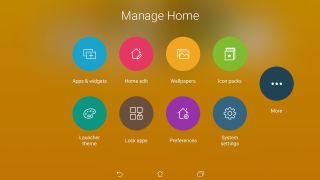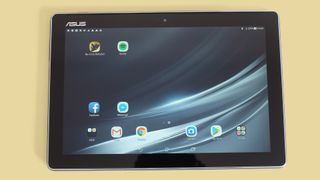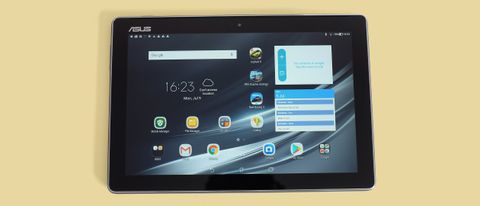Why you can trust TechRadar
Interface and reliability
- Dated core software and interface
- Highly customizable
- Supports themes
The Asus ZenPad 10 Z301ML runs Android 7.0 with Asus’s ZenUI on top. This is a double dose of datedness.
Android 7.0 is now well past its prime, and this version of ZenUI also seems stiff. It is caused in part by the screen resolution too: pixelation makes even the most slick software look old.
Asus claims the ZenPad 10 has ‘1,000 features’ not present in standard Android, but this ZenUI build is actually simpler and less bloat-filled than some earlier versions.
It used to be packed with Asus-made apps that were often not particularly useful. Now you just get a MobileManager app, which lets you check on things like security and power use, and Asus’s cloud storage service.
The extra features are found under the surface.

For example, you can choose how large app icons are, what font the system uses and the color of text on the home screen. ZenUI supports themes too, which offer a complete visual overhaul in just a few taps.
To keep the look as tasteful as possible, you’d probably only want to alter the wallpaper. But if you want to give the tablet a look the kids will like, there are plenty of cartoony themes on offer.

The ZenPad 10’s general performance is acceptable, but consistent with a budget device. App loads are slower than a powerhouse Android and you’ll see some judder as you flick quickly through websites loaded with more complicated objects.
We’ve noticed the odd bug too. Wi-Fi is a little spotty at times. It has a habit of disconnecting when your home broadband’s bandwidth is congested.
And a few times it has claimed an ‘authentication problem’ even with the right Wi-Fi password in place.
Movies and games
- Games run well enough, but don’t look great
- Solid stereo speakers lack bass
The Asus ZenPad 10 is not ideal for movies and games because of its low-res screen, but for all its faults it is still a decent tablet for media.
Properly produced 720p content looks great on this tablet, despite the lesser pixel density and color depth.
Its speakers are solid enough too. There are two drivers in a thin band above the screen, for stereo sound. They are fairly loud and the effect is much better than that of a single driver.
There’s no real bass, though. The sound is predictably not close to the iPad Pro 10.5’s.

All the games we tried ran well. In titles like PUBG and Asphalt 8 you need to use one graphics setting below max to get the smoothest results, but you don’t miss out on the ability to play high-end titles just because this is a low-end tablet.
This is, in part, thanks to the lower screen resolution. The ZenPad 10 Z301ML might well struggle if it had to render dense 3D graphics at 1200p, the ‘step up’ resolution beyond the 800p used here.
There’s a visual compromise too, though. Lower screen resolution leaves more ‘jaggies’ in 3D games. Switching between Asphalt 8 on an iPad and the ZenPad 10 feels a little like playing the game on two different console generations, the Asus obviously representing the older one.
We notice this effect less when watching movies, as a well-mastered 720p video still looks good. There are no advanced video player apps pre-loaded, but there are plenty on Google Play, and the system media player can handle a fairly wide array of file types anyway.

Performance and benchmarks
- Slow, dated MediaTek chipset
- Around a third the power of an iPad
The ZenPad 10 Z301ML has a MediaTek MT8163 chipset. This is a relatively low-end quad-core one, originally announced way back in 2015.
It uses Cortex-A53 cores and a dual-core Mali T720 GPU. It’s only a little more powerful than the Snapdragon 410 chipset used in popular phones back in 2015, such as the Moto G (2015).
Asus has packed in just enough power to let the ZenPad 10 get by, but no more.
In Geekbench 4 the tablet scores 1,786 points. The new iPad (2018) scores roughly 5,900 thanks to its Apple A10 Fusion chipset: three times as much.
The ZenPad 10 has 2015 power in 2018. But as it also has an at-best 2015 display and core 2016 software, in Android 7.0, it doesn’t totally derail day-to-day performance.
Current page: Anything else I should know?
Prev Page Battery life and camera Next Page Verdict and competitionAndrew is a freelance journalist and has been writing and editing for some of the UK's top tech and lifestyle publications including TrustedReviews, Stuff, T3, TechRadar, Lifehacker and others.


